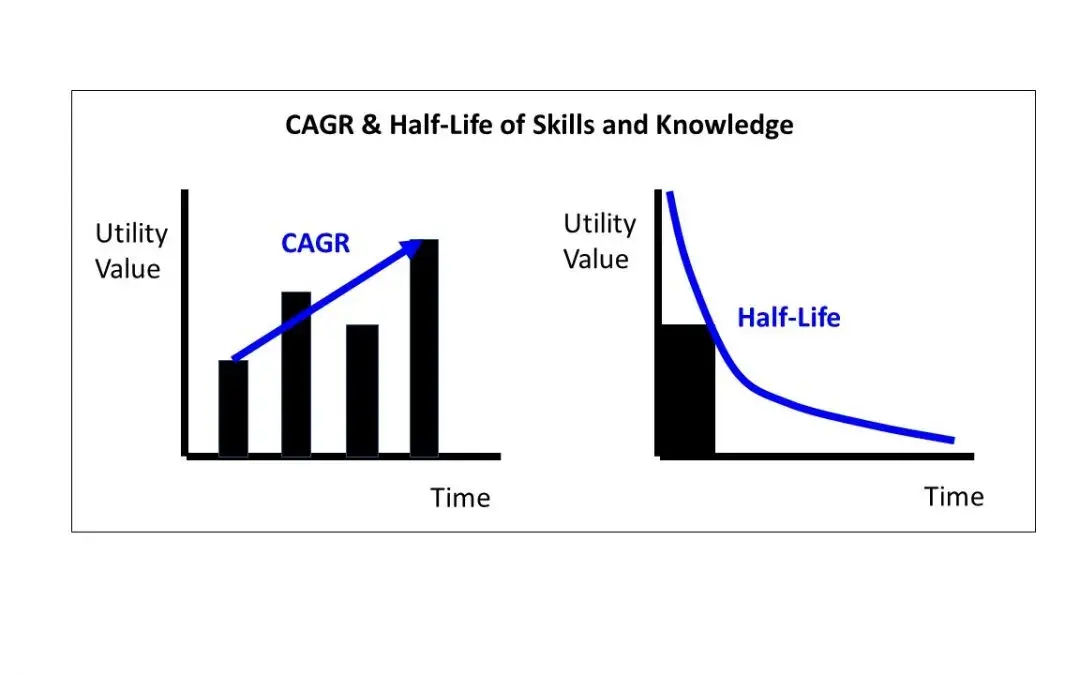Recently I had a chance to be on a panel discussion on the theme of Digital Transformation. As we were discussing, one our panel members mentioned about “Half-Life” of Skills in today’s fast-paced technology world. It aroused my curiosity as I thought that it is an interesting concept to apply for Skills. We did a bit of research on this and found several extremely interesting articles. We want to tie two ideas here one related to Growth through the concept of Compounded Annual Growth Rate (CAGR) and the other related to Decay using the concept of Half-Life.
How does it apply to Engineering Organizations?
CAGR of Skills
An engineer or a manager possesses many skills and knowledge to perform on the job. These are dependent upon the technology and industry domain. Normally most engineers are used to seeing Growth in their skills. There is an assumption that Value always increases, hence relatable to CAGR. It is a commonly used term in business to denote the growth of any phenomenon. Examples could be for revenue, unit sales or number of users. The number indicates the constant rate of growth that would take a starting value to an ending value over a particular duration. For the purposes of this article, we use CAGR to capture past data, though it can also be used for forecasts. Over a period of an engineer’s work life, due to experience and application, certain skills and knowledge grow in utility value. Every individual wishes to grow this utility value at a high rate. An individual’s investment on honing the same determines the growth.
Half-Life of Skills
Now let us look at Decay. Half-Life was originally used in Nuclear Physics, which is the time required for a quantity to reduce to half of its initial value. The term describes how quickly unstable atoms undergo radioactive decay or how long stable atoms survive (https://en.wikipedia.org/wiki/Half-life). However, for our purpose, we can generalize this concept to describe any phenomenon where “Over what duration a utility value or worth decreases by Half”. Contrary to what an engineer wishes, Skills and Knowledge also Decay over time. Most often the market and industry conditions determines this decay.
Variety of Skills
We can apply this phenomenon to any of the skills and knowledge. Usage of certain tools, skills in specific technologies, practices like critical thinking, problem solving, communication, best practices & lessons learnt, industry or domain specific nuances or transfer learning from one domain to another are all good examples of skill and knowledge. Some Emotional Quotient (EQ) related competencies can also qualify for this category.
We then can categorize these skills and knowledge and put side by side the CAGR and an estimate their Half-Life. The utility value diminishes on account of obsolescence or disruptions in the domain with entry of new ones. While one might have a spent long time in accumulating certain skills, they might lose their significance over a short period of time due to lack of application. What used to be Half-life of 5-6 years for technologies and skills earlier in many domains have now reduced to as low as 2-3 years. This is especially true for digital transformation technologies. In simple terms many skills can lose their value and become obsolete in much shorter durations.
How can one use both the above ideas at an individual level?
We propose that it is very important to view Skills and Knowledge from both the perspectives of past CAGR and Half-Life which is in the future. As an engineer one can start by capturing the Portfolio of Skills and Knowledge that one possesses. Then one can do an analysis and develop a good understanding on which skills and knowledge in this portfolio. One also needs to be aware of which of the skills have accumulated value and have grown at a good rate. A particular skill or an industry specific knowledge can dramatically accumulate value when there is a surge in demand. More so some game changer ideas or technology can create such a surge. For example, in Digital Transformation – Smartphone apps led services, Smart Devices, Social Media led engagement, Cloud Enablement, Data Analytics, Artificial Intelligence and Machine Learning to name a few.
On the other hand, many skills are likely to erode in utility value as quantified by Half-Life. The half-life period would be a good point for a decision, to drop the skill from the portfolio sometime soon and potentially replace with another skill. This is irrespective of the time that has taken to accumulate the same. The half-life is generally determined by the rapidity of changes in that technology or industry domain. This may also be dependent upon the speed of changes and strategies pursued within a particular company.
What is the implication for Organizations?
First it is about Enterprise Agility and how people are organized in terms of Agile Teams to adapt to the changes and continuously deliver customer value. Within teams, there is a need to have people with T-Shaped Skills. Each team member not only have deep skills in one or two areas but also have broad complementary skills to the extent practical – Portfolio of Skills. The leadership and management in organizations have to help team members in managing this portfolio and track both Half-Life and CAGR. The portfolio would also apply at the team and organization level.
Then it is incumbent on leadership to continuously make investments on growing skills and knowledge and prune the eroding ones. At the same time, an individual has to embrace life-long learning to actively manage the portfolio. Some individuals might end up having a non-performing portfolio whereas some others may build a high-performing portfolio. A combined high-performing portfolio of Skills would benefit individuals, teams and organizations.





2 Responses
A thought-provoking post.
Interesting post . Just that skill needs are fuelled by demand . One can see upticks in need for legacy too